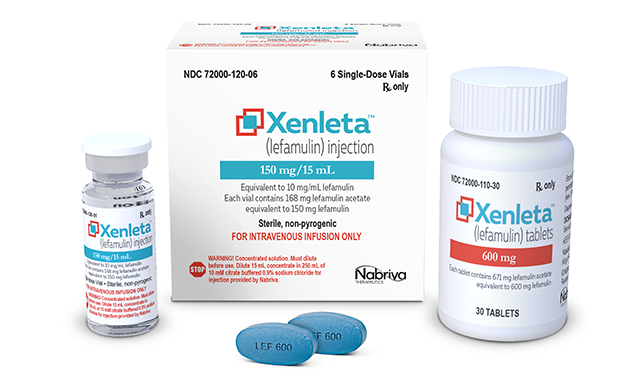Lefamulin Could Be Vital in the Pneumonia Fight
The drug comes at a time when antibiotic resistance worries are high. Here’s why it matters.

Lefamulin Efficacy; Click to View

Use hand sanitizers, cover your mouth, wash your hands, wear a mask-the byword messages of public health agencies are upon us once again as temperatures drop. In an era of increasingly drug-resistant pathogens, widespread efforts to prevent the spread of infectious disease are laudable.
Nonetheless, providers who treat severe respiratory illness say it is particularly troublesome for older people whose bout with influenza often results in community-acquired bacterial pneumonia (CABP). Depending on the bacterial strain, resistance is widespread, making the infection a tough contender to cure at any age-but especially in older people.
This season, however, providers will have a new and better choice for the treatment of CABP, a disease whose risk not only increases with age but is a significant burden of illness for about 5 million people in the U.S. each year. A study of claims data from nearly 2 million individuals 65 years and older enrolled in a Medicare Advantage Plan found that, in 2015, the CABP-related hospitalizations incurred medical costs in excess of $18,000 with an average length of stay of 5.6 days.
Trending: The 10 Best-and Worst-States for Vaccinations
In August, the FDA approved XENLETA (lefamulin, Nabriva Therapeutics plc), a new antibiotic that is forecast to have a significant impact on patients with CABP and is hailed as a significant breakthrough for the treatment of antibiotic-resistant disease.
Nabriva’s chief commercial officer (CCO), Francesco Maria Lavino, PharmD, reports, “This is tremendously exciting as not only is XENLETA a new molecule, it is a new molecule in a brand-new class of IV and oral anti-infective drugs, and this has not happened in almost 20 years. And, it is also the first new-class antibiotic that has been approved in both oral and IV form which is very important because it gives physicians wider treatment options.”
XENLETA is available for oral (600 mg every 12 hours) and intravenous (150 mg every 12 hours) administration with a short 5-to-7 day course of therapy.
He explains the unique mechanism of action of this novel molecule-lefamulin.
“The drug inhibits the bacterial protein synthesis by binding the 50S ribosomal subunits through multiple interactions, and it is in the way it binds to the ribosomal site that is different from any other antibiotic. This results in a low risk of developing resistance to XENLETA as well as a low risk of developing resistance to older antibiotic classes such as the beta-lactams, fluoroquinolone, macrolide, and tetracycline antibiotic classes.
“When you have multiple binding sites it becomes more difficult for the bacteria to mutate to prevent the antibiotic from working and at the same time, retain its fitness and ability to replicate. Overcoming drug resistance is a function of inhibiting bacteria that have created already-created mechanisms to resistance to other drugs. By inhibiting the bacteria with this type of interaction, which is the hallmark of this new molecule, we achieve both effective treatment outcomes and overcome propensity toward resistance at the same time.”
The recent Antimicrobial Agents and Chemotherapy article reported on the efficacy of lefamulin as the first semisynthetic pleuromutilin antibacterial for intravenous and oral treatment of community-acquired bacterial pneumonia. Results from the 2015-1016 SENTRY Antimicrobial Surveillance Program state that XENLETA (lefamulin injection, tablets) was highly active against the most common pathogens in pneumonia-including strains that are multidrug resistant.
New Antibiotics Needed
Julio A. Ramirez, MD, professor of medicine, and chief, Division of Infectious Diseases at the University of Louisville underscores the need for a new class of antibiotics that fight resistance.
“The bacteria that have caused CABP have remained the same, but each one of these bacteria have developed the capacity to fight against the antibiotics that we regularly use to treat pneumonia.”
He says the bacteria that cause pneumonia typically classified as either typical or atypical pathogens.
“To treat these two groups of bacteria in hospitalized patients, sometimes we use two different classes of antibiotics. The advantage of XENLETA is that we can treat these two types of bacteria with a single antibiotic. Once patients are hospitalized with CABP, we can start IV XENLETA as a single antibiotic therapy; once patients improve, we can use the same antibiotic in an oral formulation and achieve an early hospital discharge.”
Ramirez says the launch of XENLETA is very important as it offers a new class of antibiotic with documented clinical efficacy in patients with CABP.
“This is a very common infection and is considered one of the primary infection-related causes of death in the U.S.,” he says.
Read More: The Growing Problem of Pharmacy Deserts
Lavino underscores this importance for new options, saying the drug is “going to be an ideal choice for CABP patients and will give providers a well-tolerated and effective option, particularly considering that 30% to 60% of S. pneumoniae are reported to be macrolide resistant.”
From a clinical perspective, he says physicians can offer patients who show up to the ER an opportunity to initiate therapy with an oral medication and prevent hospitalization if their condition does not warrant admission.
“Even if they are admitted for a day or two, they can start on the IV XENLETA and then go home and continue on the oral therapy. Many times, physicians will admit patients, but they know that macrolide treatment has resistance and while the efficacy of broad-spectrum fluoroquinolones on CABP are excellent, there are many boxed warnings that often deter a physician’s use of this drug.” Lavino adds that this continuity of treatment-the same drug from hospital to home-is important.
Philip Giordano, MD, FACEP, vice chairman of Orlando Regional Medical Center Department of Emergency Medicine says he is “very excited to have XENLETA added to our pneumonia armamentarium.”
The drug, Giordano says, is particularly exciting because it plays into the trend of moving patients into outpatient management as much as possible. “Outpatient management reduces costs, increases patient satisfaction, and avoids exposing patients to nosocomial infections.”
“Currently, many patients with CABP are admitted to the hospital solely because of the lack of confidence in currently available oral agents. The introduction of a new antibiotic with potency, ease of use, and a safety profile that clinicians can be confident in will increase the opportunities for outpatient management,” Giordano says.
One study, Lavino says that LEAP 2, showed that in just five days of monotherapy XENLETA’s effectiveness for CABP is the same as seven days of moxifoxicin.
“Along with the appropriate spectrum of coverage for the right bugs, this is another important principle of stewardship, to treat in the shortest duration to be effective,” says Lavino. “So you can send more patients home and prevent hospitalizations and the costs incurred, as well as the stress and risk of that event upon the patient.” He adds that the current median length of a CABP-related hospital stay is three to four days and that direct costs of pneumonia is estimated to be approximately $17 billion in the U.S.
He reports that Nabriva “initiated a lot of pre-work to the launch by profiling the main accounts and the managed care team has been engaging payers to accelerate coverage. XENLETA is covered by Medicare for inpatient use and most commercial plans follow that lead since most hospitalizations are treated under a DRG single payment system and in the next few months we expect the majority of commercial plans to review and approve the drug.”
The company says the wholesale acquisition (WAC) price is $205 per IV treatment day and $275 per oral patient treatment day.
However, adopting a new therapy often poses reimbursement challenges to the system and Giordano says, “Differences in the way hospitals add to their formularies can affect the adoption of a new intravenous drug. When an oral form is available in the case of XENLETA, adoption is not formulary dependent and can begin immediately by ED physicians, internists, and pulmonologists for their pneumonia or even suspected pneumonia patients.”
Trending: The Redefinition of Pharmacy Jobs
Contraindications include patients with known hypersensitivity to XENLETA or pleuromutilin and XENLETA tablets are contraindicated for use with CYP3A4 substrates that prolong the QT interval. Warnings and cautions state that the drug has the potential to prolong the QT interval and should not be used in patients with known QT prolongation, ventricular arrhythmias, or who are taking drugs that may prolong the QT interval.
“CYP3A is a route of metabolizing the drug, and other drugs share that same metabolism,” Lavino explains. “So you can be taking an inducer which would render XENLETA less effective, or you could be taking an inhibitor, in which case you have more drug in the blood. The label is clear on warning against concomitant use of inducers or inhibitors of this metabolic pathway”
The FDA granted approval of both the oral and IV form of XENLETA via their Qualified Infectious Disease Product (QIDP) and Fast Track designations. The QIDP guidance is designed to encourage the development of new antibiotics to address the growing microbial resistance problems in treating disease.
